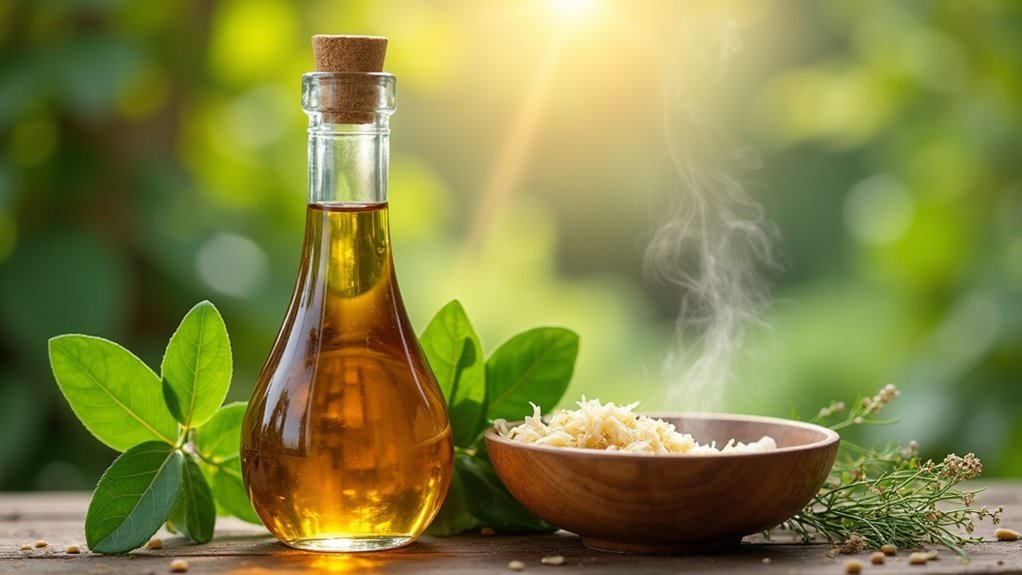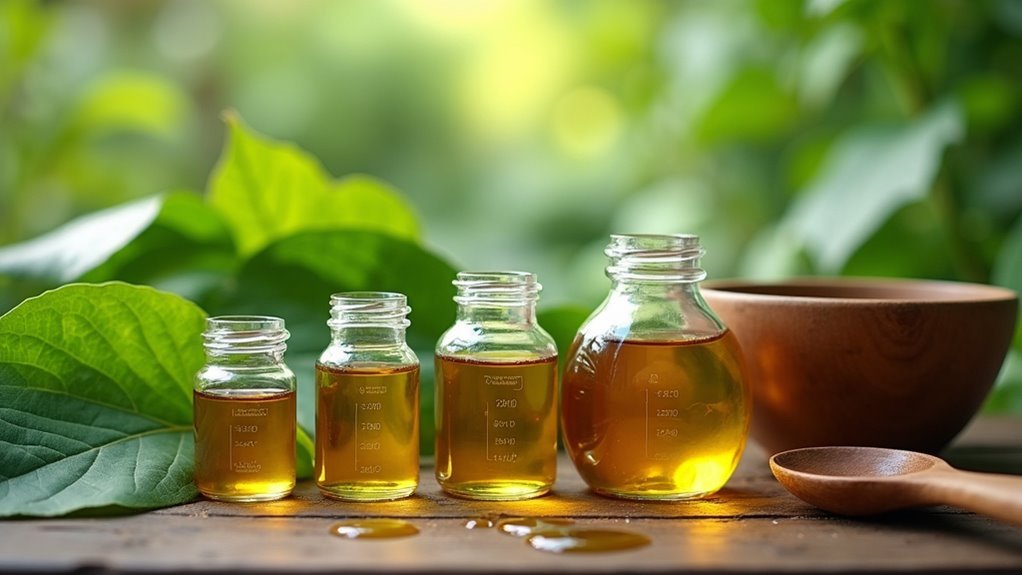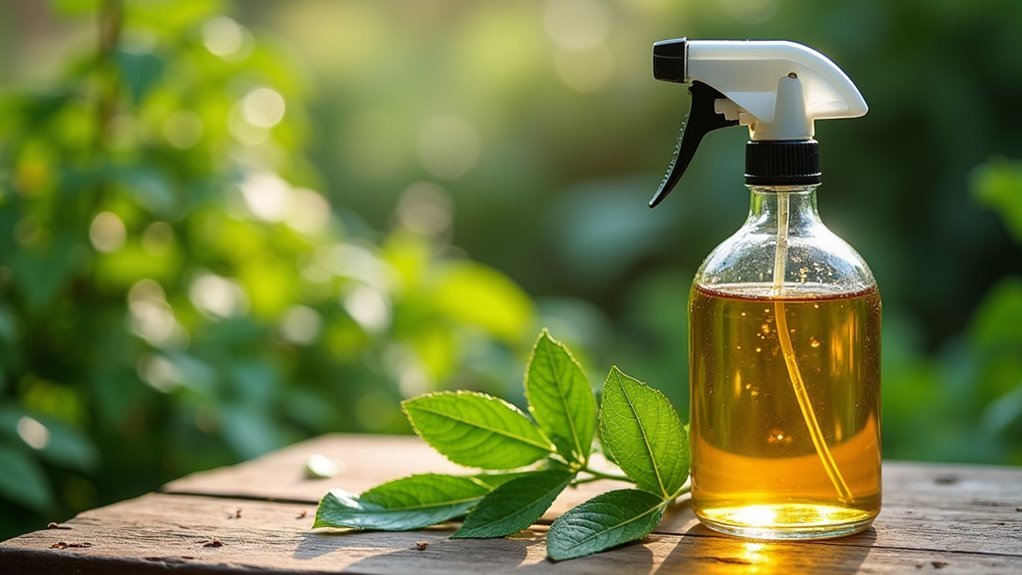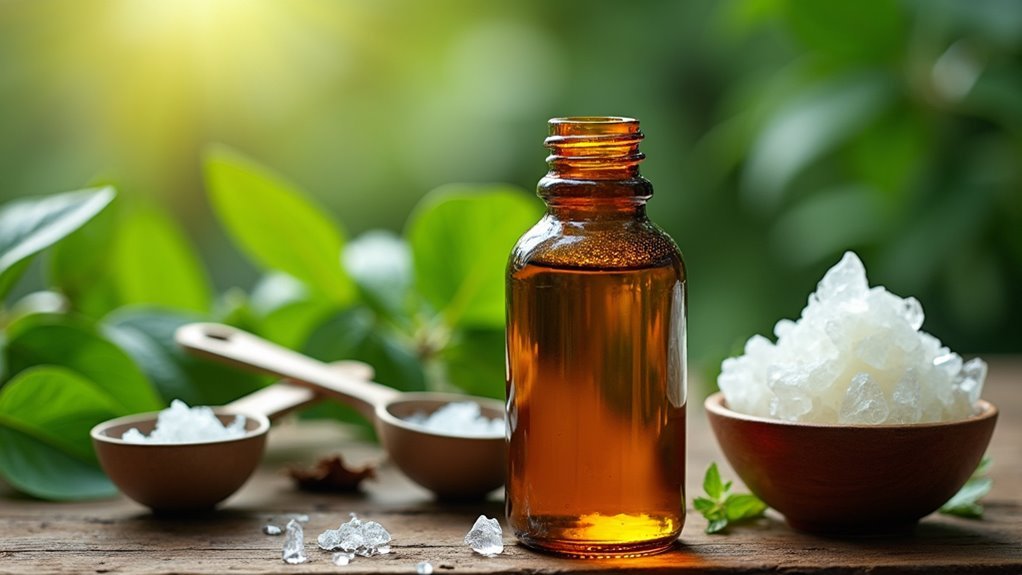You’ll need just three ingredients to make an effective neem oil fungicide: mix 1.5 teaspoons of 100% pure neem oil with one quart of purified water and 0.5 teaspoons of gentle dish soap as an emulsifier. Shake the mixture thoroughly and apply using a spray bottle during early morning or late afternoon hours. This natural solution targets blackspot, powdery mildew, and rust while controlling over 200 insect species. There’s much more to mastering proper application techniques and timing.
What Is Neem Oil and How Does It Work as a Natural Fungicide

Gardeners seeking effective, eco-friendly disease control have discovered a powerful ally in neem oil, a natural fungicide extracted from the seeds of the Azadirachta indica tree. This botanical solution offers low toxicity while delivering powerful results against common plant diseases.
Neem oil works by disrupting fungal growth and reproduction cycles, effectively controlling blackspot, powdery mildew, and rust infections. The key compound azadirachtin enhances its fungicidal properties while simultaneously providing insect control, making it a dual-purpose garden solution.
Azadirachtin disrupts fungal cycles while controlling insects, making neem oil an effective dual-purpose treatment for multiple garden threats.
You’ll achieve ideal results by applying neem oil during early morning or late afternoon hours to prevent leaf burn and maximize plant absorption.
Regular applications every 7-14 days during growing season help prevent fungal outbreaks before they establish.
Benefits of Making Your Own Neem Oil Spray Vs Store-Bought Options
When you make your own neem oil spray, you’ll control the concentration to match your specific plant needs rather than settling for weak commercial formulations that often contain less than 3% active ingredients.
You’ll save money by mixing only what you need and avoid the markup costs of pre-made products.
Your homemade spray stays fresh and potent since neem oil degrades quickly once mixed, giving you maximum effectiveness against fungal problems.
Higher Concentration Control
While store-bought neem oil sprays offer convenience, creating your own fungicide solution delivers superior concentration control that can make the difference between marginal and exceptional results.
You’ll typically achieve azadirachtin concentrations exceeding 3%, considerably higher than most commercial alternatives. This enhanced potency proves especially valuable when dealing with persistent fungal infections or implementing an extensive preventative measure strategy.
Your homemade mixture allows precise adjustments based on plant sensitivity and infection severity. Delicate seedlings require gentler concentrations, while established plants battling severe fungal issues benefit from maximum strength applications.
Store-bought products can’t offer this flexibility – they’re formulated for general use, not your specific situation. By controlling concentration levels yourself, you’re optimizing treatment effectiveness while minimizing potential plant stress, ensuring healthier outcomes for your garden.
Cost Savings Benefits
Beyond enhanced potency, you’ll discover considerable cost savings when mixing your own neem oil fungicide.
Store-bought neem sprays typically contain less than 3% azadirachtin and cost markedly more per application than homemade alternatives. When you prepare your own solution, the ingredient costs remain consistently lower than purchasing commercial products regularly.
You’ll also control pests more effectively with higher concentrations, reducing your need for additional treatments and supplementary pest control products.
The quality and freshness of ingredients you choose leads to better results with less waste compared to pre-made solutions. Many gardeners report improved plant health after switching to homemade neem oil sprays, ultimately spending less on various pest management products while achieving superior protection for their plants.
Freshness and Potency
Fresh neem oil maintains maximum potency that deteriorates rapidly once mixed with water. You’re guaranteed optimal freshness when crafting your own solution from quality neem oil, unlike store-bought sprays that may sit on shelves for months.
Homemade preparations deliver higher azadirachtin concentrations compared to commercial options containing less than 3%. Making small batches guarantees you’re using the solution at peak effectiveness, since neem oil loses potency after 8 hours in water.
You control ingredient quality and mixing ratios, maximizing natural insecticidal and fungicidal properties. Store-bought alternatives can’t match the freshness factor of immediately-prepared solutions.
Your plants receive the full benefit of potent, active compounds that haven’t degraded through extended storage or diluted formulations.
Essential Ingredients and Supplies for DIY Neem Oil Fungicide
Although creating an effective neem oil fungicide requires only a few key components, selecting the right ingredients makes all the difference in protecting your plants from fungal diseases.
You’ll need 100% pure neem oil to guarantee maximum potency against fungal infections. Don’t compromise with diluted versions that reduce effectiveness.
For your mixing supplies, gather one gallon of purified water and two teaspoons of gentle dish soap, which acts as an emulsifier to blend the oil properly.
A high-output spray bottle guarantees even distribution across all leaf surfaces, especially undersides where fungi thrive.
Remember to mix only what you’ll use immediately, as neem oil degrades within eight hours of combining with water.
Always test on a small plant section first.
Step-by-Step Mixing Instructions for Different Batch Sizes

Three different batch sizes will cover most gardening needs, from treating a few houseplants to protecting an entire garden.
Each recipe uses pure neem oil mixed with water and gentle dish soap as an emulsifier, creating a solution that’s safe for humans when properly diluted.
Pure neem oil, water, and gentle dish soap combine to create an effective, human-safe gardening solution when properly diluted.
- Quart-sized batch: Combine 1.5 teaspoons neem oil with 1 quart water and 0.5 teaspoons dish soap. Perfect for small indoor collections or spot treatments.
- Half-gallon batch: Mix 1 tablespoon neem oil with 1/2 gallon water and 1 teaspoon dish soap. Ideal for medium-sized gardens or multiple plant areas.
- Full-gallon batch: Blend 2 tablespoons neem oil with 1 gallon water and 2 teaspoons dish soap. Best for large gardens or extensive infestations.
Always shake thoroughly before application and use within 8 hours for maximum effectiveness.
Why Small Batches Are Critical for Maximum Effectiveness
You’ll discover that neem oil’s active compounds break down rapidly once mixed with water, losing their pest-fighting power within just a few hours.
This quick degradation means you can’t prepare large batches ahead of time and expect them to remain effective for days or weeks.
Neem Oil Degrades Quickly
When you mix neem oil with water, it starts breaking down immediately and loses its fungicidal power within just a few hours. This rapid degradation makes timing essential for effective pest control applications.
Here’s why fresh mixtures matter:
- 8-hour window – Your oil and water solution maintains peak effectiveness only within the first 8 hours after mixing.
- Waste prevention – Small batches guarantee you’re not throwing away weakened solutions that won’t deliver results.
- Consistent potency – Fresh preparations assure maximum strength for tackling fungal issues and pest problems.
You’ll need to reapply every few days since neem oil takes time to show visible effects.
Preventing Waste Through Timing
Since neem oil’s potency diminishes rapidly once mixed with water, calculating the exact amount you need for each application becomes your most powerful strategy for preventing waste. You’ll want to measure your garden area and determine how much solution you’ll actually use before mixing.
| Garden Size | Water Amount | Neem Oil Amount |
|---|---|---|
| Small pots | 1 cup | 1/2 teaspoon |
| Medium beds | 1 quart of water | 2 teaspoons |
| Large areas | 1 gallon | 8 teaspoons |
This approach guarantees you’re not left with degraded solution after 8 hours. When you mix only what you need, you’ll maintain maximum effectiveness while preventing waste. Remember, it’s better to make a second small batch than to throw away leftover solution that’s lost its pest-fighting power.
Proper Application Techniques for Best Coverage

Achieving thorough coverage with your neem oil fungicide requires strategic spraying techniques that target every plant surface where fungal spores and pests can lurk.
Using a high-output spray bottle guarantees you’ll get the fine mist needed for even distribution across all leaf surfaces.
A quality spray bottle with high output creates the fine mist essential for complete leaf coverage and effective neem oil application.
Follow these essential application techniques:
- Target all leaf surfaces – Spray generously on tops and undersides of leaves, where pests typically hide and fungal issues develop.
- Time your applications wisely – Apply during early morning or late afternoon to prevent leaf burn from direct sunlight.
- Shake before each use – Mix the solution thoroughly to maintain proper emulsification between neem oil, water, and dish soap.
Reapply every 7-14 days for prevention, or twice weekly during active infestations for ideal fungal control.
Optimal Timing and Frequency for Neem Oil Treatments
Beyond proper spray techniques, timing your neem oil applications correctly makes the difference between successful fungal control and wasted effort. You’ll want to spray during early morning or late afternoon when direct sunlight won’t reduce effectiveness or stress your plants.
| Treatment Type | Frequency | Duration |
|---|---|---|
| Prevention | Every 7-14 days | Growing season |
| Acute infestation | Twice weekly | Until resolved |
| Heavy treatment | Every 3-4 days | 2+ weeks |
Always test neem oil mixed with water on a small plant section first. For complete elimination of stubborn fungal issues, you’ll need consistent applications every three to four days, as effects take two or more days to become noticeable. This systematic approach guarantees thorough control while protecting your plants from unnecessary stress.
Essential Safety Tips and Plant Testing Methods
How can you guarantee neem oil treatments protect rather than harm your plants? Following proper safety protocols prevents damage and guarantees successful fungal control.
Always shake your neem oil mixture thoroughly before each application, as the oil naturally separates from water. Start with a diluted solution of 1.5 teaspoons per quart of water to minimize leaf burn risk.
Proper mixing and dilution are essential first steps to prevent neem oil from burning delicate plant tissues.
Here are three critical safety steps:
- Conduct a patch test – Apply solution to a small, hidden area and wait 24 hours before full treatment.
- Time applications wisely – Avoid treating during peak sunlight hours to prevent oil-amplified plant damage.
- Monitor plant response – Watch for wilting, discoloration, or leaf drop after initial treatments.
Store unused mixture in cool, dark conditions and use within 8 hours for maximum effectiveness.
Common Fungi and Pests Controlled by Neem Oil
You’ll find neem oil effectively targets three major fungal diseases that commonly plague garden plants: blackspot, powdery mildew, and rust.
Beyond fungal control, this versatile oil combats over 200 insect pest species, including destructive aphids, caterpillars, and mealybugs that can devastate your plants.
The azadirachtin compound in neem oil disrupts both fungal reproduction and insect feeding cycles, giving you thorough protection against your garden’s most persistent threats.
Fungal Disease Control
While synthetic fungicides can harm beneficial insects and contaminate soil, neem oil provides a natural defense against numerous plant diseases without the environmental risks.
You’ll find this organic solution effectively combats powdery mildew, black spot, and rust through its active compound azadirachtin, which disrupts fungal growth and reproduction.
When you apply neem oil as a foliar spray, it creates a protective barrier that prevents fungal spores from settling and germinating on your plants.
Here’s how neem oil controls fungal diseases:
- Disrupts fungal lifecycle – Azadirachtin interferes with spore development and mycelium growth
- Creates protective coating – Forms a barrier that repels new fungal infections
- Prevents spore germination – Stops fungi from establishing on leaf surfaces
Regular applications every 7-14 days considerably reduce infection risks while promoting healthier plant growth.
Target Pest Species
Beyond its impressive fungal control capabilities, neem oil targets an extensive range of soft-bodied insects that commonly plague garden plants. Cold pressed neem oil is particularly effective because it retains the highest concentration of azadirachtin, the primary active compound responsible for pest control.
| Fungal Diseases | Soft-Bodied Pests | Plant Damage |
|---|---|---|
| Blackspot | Aphids | Leaf distortion |
| Powdery mildew | Mealybugs | Stunted growth |
| Rust | Caterpillars | Yellowing foliage |
| Anthracnose | Spider mites | Reduced vigor |
You’ll find neem oil is used to control these pests by disrupting their feeding patterns and reproductive cycles. The azadirachtin compound acts as both an antifeedant and growth regulator, making affected insects less likely to feed and reproduce successfully on your plants.
Storage and Shelf Life Guidelines for Homemade Solutions
Since homemade neem oil solutions lose their potency rapidly, you’ll need to use them within 8 hours of mixing for maximum effectiveness.
Proper storage practices will help maintain whatever potency remains if you can’t use the entire batch immediately.
Follow these essential storage guidelines:
- Store in cool, dark locations – Keep unused solution away from sunlight and heat sources to slow degradation.
- Label with mixing date – Write the preparation date on your storage container to track freshness accurately.
- Discard after 48 hours – Make sure to throw out any solution older than two days and prepare a fresh batch.
Avoid freezing your neem oil solution, as the thawing process can compromise its effectiveness.
Instead, maintain room temperature storage when not actively applying the fungicide to your plants.
Frequently Asked Questions
How Do You Mix Neem Oil for Fungicide?
You’ll mix 1.5 teaspoons of pure neem oil with 1 quart of water, then add 0.5 teaspoons of liquid dish soap. Shake well in ventilated areas before applying immediately.
What Is the Ratio of Neem Oil to Water for Plants?
You’ll need 1.5 teaspoons of neem oil per quart of water, or scale up to 2 tablespoons per gallon. Always add 2 teaspoons of dish soap per gallon for proper emulsification.
How to Make a Neem Oil Solution for Plants?
Mix 2 tablespoons of pure neem oil with 1 gallon of water and 2 teaspoons of liquid dish soap. Shake well, then apply generously to all leaf surfaces including undersides.
What Is the Best Mixture for Neem Oil?
You’ll want 1.5 teaspoons of pure neem oil mixed with 1 quart water and 0.5 teaspoons dish soap. For larger batches, use 2 tablespoons neem oil per gallon with 2 teaspoons soap.
In Summary
You’ve now got everything you need to create an effective neem oil fungicide that’ll protect your plants naturally. Remember to mix small batches fresh, test on a few leaves first, and apply during cooler parts of the day. With consistent applications every 7-14 days, you’ll keep fungal diseases at bay while saving money compared to commercial products. Your plants will thank you for this gentle yet powerful organic protection.





Leave a Reply